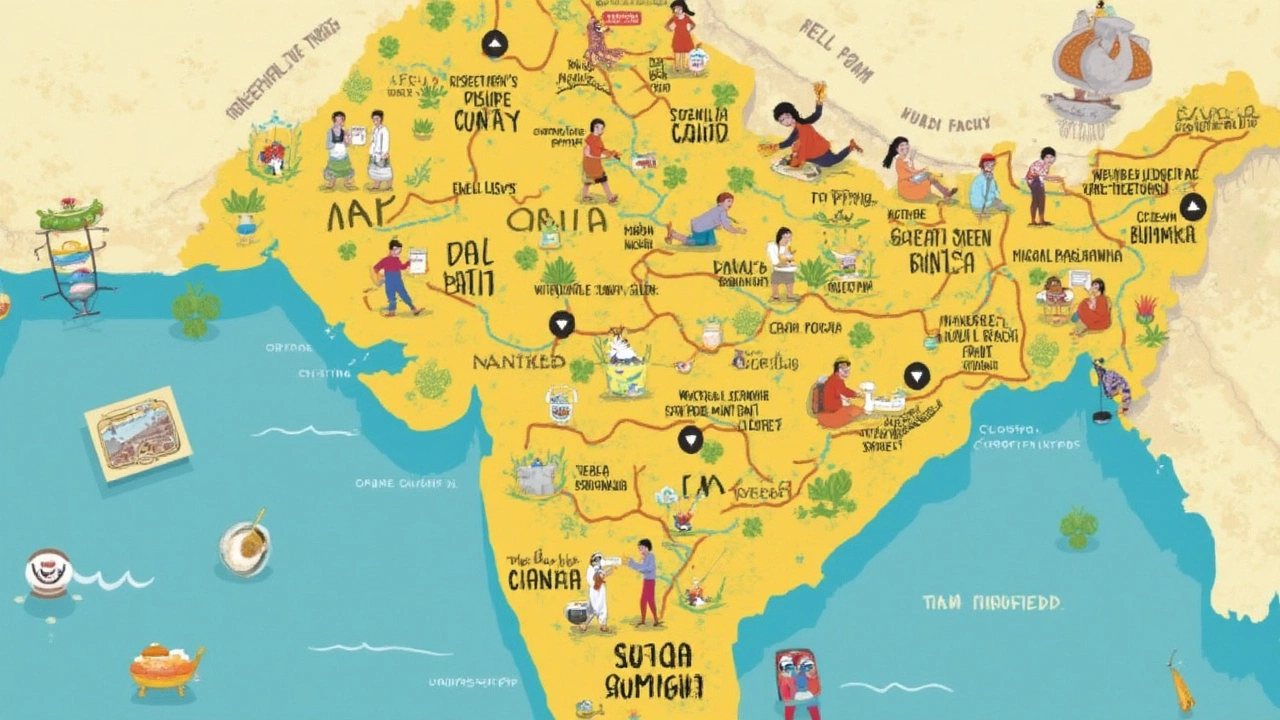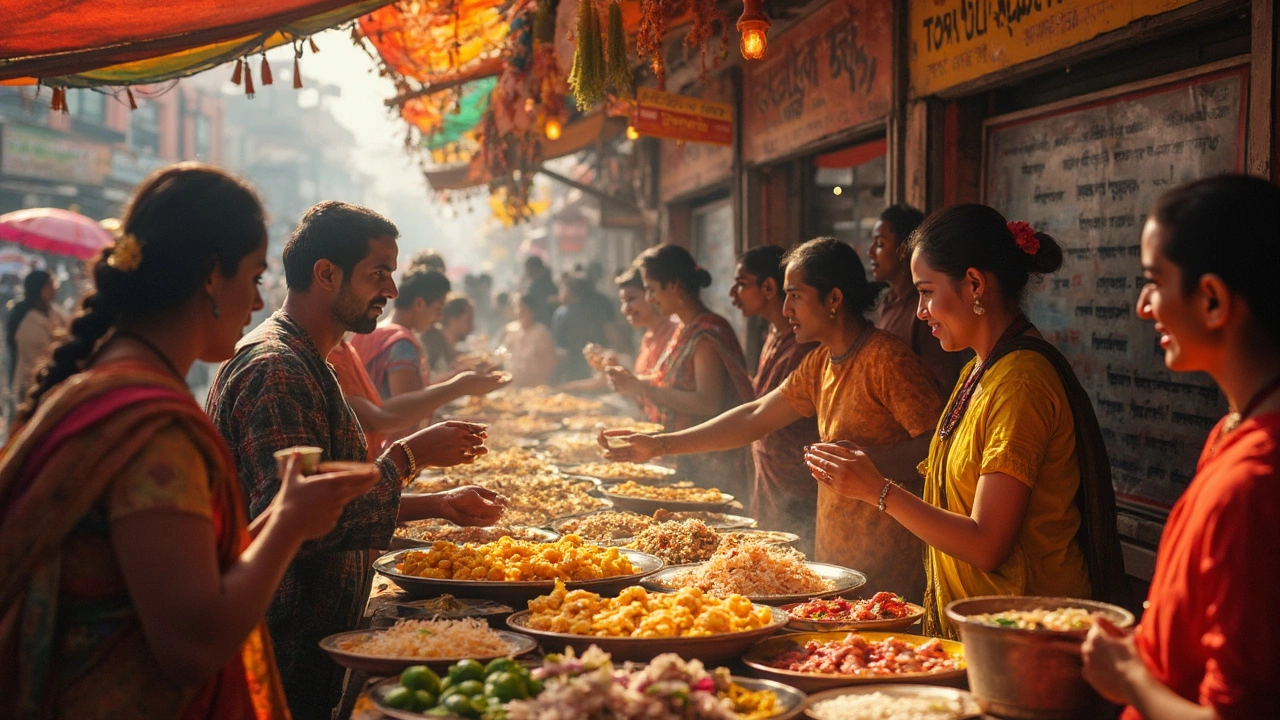The idea of a 100% vegetarian country sounds pretty wild, doesn’t it? You might hear people say, “Everyone in India is vegetarian!” or “There’s a country where nobody eats meat!” But if you look closer, you’ll see that there’s actually no country on earth that’s totally vegetarian—not even India, which is famous for its love of plant-based food.
What’s the real story? India probably comes the closest, with a massive range of vegetarian dishes and millions of people who never touch meat. Still, meat and fish have a place in many Indian homes, festivals, and street foods. No border keeps out meat from everyone’s plate—even in countries where it’s uncommon. If you’re dreaming of seeing a purely vegetarian nation, you’re going to be disappointed. But what you will find are places where vegetarian food isn’t just “an option”—it’s the star of the show, especially in India.
- The 100% Vegetarian Country Myth
- India: The World’s Vegetarian Hub
- Vegetarian Indian Dishes to Try
- Challenges of Being a Vegetarian Traveler
- Tips for Vegetarian Eating Worldwide
The 100% Vegetarian Country Myth
This idea that there’s a totally vegetarian nation sounds nice, but it just isn’t real. There’s no country, anywhere, where you’ll find the entire population eating only plants. Even in countries with strong religious or cultural ties to vegetarian food, someone is always firing up a grill or fishing for dinner.
Take India, for example. People usually think of India as the land of vegetarians. It’s true that a large percentage dodges meat—around 38% of the population, according to the National Family Health Survey 2019–21, identifies as vegetarian. That’s a lot, but it’s not close to all. Actually, here’s how it looks for India and a few other countries:
| Country | % of Vegetarians |
|---|---|
| India | 38% |
| Israel | 13% |
| Italy | 10% |
| Germany | 5% |
| USA | 5% |
Not only is there no 100% vegetarian country, but most countries hover well below the halfway mark. Even places with a strong culture of plant-based eating have city markets and restaurants selling meat, eggs, or fish just about everywhere.
If you’re looking for a place that truly “gets” what it means to eat veg, India is your best bet for finding tons of variety and support. But the myth of the 100% vegetarian country? It just doesn’t line up with the facts. People are different. Preferences change from family to family, or even meal to meal, and food customs never fit neatly into national borders.
India: The World’s Vegetarian Hub
When people talk about vegetarian food, India usually pops up first. That’s not just hype—around 30-40% of Indians eat mostly or fully vegetarian diets, which adds up to hundreds of millions of people. No other country comes close to that number. But here’s the real surprise: most Indians aren’t strict vegetarians! The numbers are still massive, though, so if you’re looking for the world’s best spot for plant-based eating, India is still the gold standard.
What makes vegetarian food in India so popular? Religion has a big say. Hindus, Jains, and some Buddhists follow vegetarian rules, sometimes very strict ones. For example, Jains won’t even eat garlic or onions, and they definitely avoid any food that harms tiny living things. On top of that, a lot of families and whole communities (like Brahmins and Marwaris) pass down vegetarian traditions going back generations.
Restaurants in India really get it right. Entire cities are famous for mostly vegetarian food. Cities like Ahmedabad and Udaipur come pretty close—some restaurants there don’t even offer meat at all. Even fast food chains in India sell things like McAloo Tikki burgers, which is a spicy potato patty instead of a beef burger. Local trains and lunch services also focus on vegetarian meals.
Walking around markets or dining with Indian families, you’ll see just how creative Indian vegetarian cooking is. Curries, korma, dosas, dal, chaats—each region has specialties that don’t use meat or eggs. The sheer range means you’ll never get bored, no matter how long you stick to veggie food here.
It’s easy to see why India is usually called the world’s vegetarian hub. The history, the traditions, and the flavors all add up. If you want to eat vegetarian without stressing, India is where you can actually relax and enjoy the best of what plant-based food has to offer.

Vegetarian Indian Dishes to Try
If you think all Indian vegetarian food is just curry and rice, you’re about to get surprised. India has a massive variety of vegetarian meals that go way beyond what most restaurants outside India offer. These aren’t just side dishes—they’re hearty, full-flavored meals people eat every day, and they don’t rely on complicated ingredients.
Let’s look at some favorites that locals swear by. You’ll spot these dishes in homes, street-food stalls, and sit-down restaurants from Delhi to Chennai:
- Paneer Butter Masala: A creamy tomato-based curry with cubes of paneer (fresh cheese). It’s rich, mildly spiced, and loved for its comfort factor.
- Dal Tadka: A staple made with yellow lentils, fried spices, and sometimes a dash of lemon. It goes with rice or roti and is pure comfort for millions of Indians.
- Dosa: A thin, crispy pancake from South India, made from a rice and lentil batter. Usually stuffed with spiced mashed potatoes and paired with coconut chutney.
- Chole Bhature: A North Indian hit—spicy chickpea curry served with deep-fried, fluffy bread. It’s a weekend treat in many households.
- Baingan Bharta: This smoky mashed eggplant dish uses roasted eggplants, onions, tomatoes, and spices. It’s earthy and pretty easy to make at home.
- Rajma: Think red kidney beans in a thick, spicy gravy. Rajma chawal (with rice) is soul food in Northern India.
- Aloo Gobi: Potatoes and cauliflower tossed with turmeric, cumin, and a hit of ginger-garlic. Real crowd-pleaser and easy to cook in one pan.
Some regions are even stricter about vegetarian food, especially in states like Gujarat, Rajasthan, and in Jain and some Hindu communities. In these places, you won’t find onion or garlic in traditional recipes—a choice rooted in religious beliefs.
Here’s a sneak peek at just how popular vegetarian food is in India:
| State/Region | Est. % Vegetarian | Specialty Dish |
|---|---|---|
| Rajasthan | 74% | Gatte ki Sabzi |
| Gujarat | 61% | Dhokla |
| Punjab | 26% | Saag Paneer |
| Kerala | 2% | Avial |
As you can see, there’s no single style. Whether you love hearty lentils, crispy snacks, or just want to fill up on flavorful veggies, India’s vegetarian scene covers all the bases. If you ever want to taste real Indian vegetarian dishes, don’t just stick to what’s popular at your local takeaway—try recipes from different regions, and you’ll get a whole new world on your plate.
Challenges of Being a Vegetarian Traveler
Traveling as a vegetarian isn’t always a walk in the park, even in places where you’d expect it. In countries where meat and seafood are the main part of the diet, just finding a simple veggie meal can turn into a mini-adventure.
Some countries are famous for their meat-heavy food scenes. Take Brazil or Argentina, for example—so much of the cuisine centers around grilled meats that vegetarians might feel a little left out. Language barriers make it trickier; if you don’t speak the local language, it’s easy to end up with a dish that “looks” vegetarian but sneaks in meat stock or fish sauce. Even in India, which is often called the 100% vegetarian country (it’s not!), you have to keep an eye out—some sweets and curries hide ghee or gelatin, so reading labels or asking questions is a real must.
Dairy and eggs are another stumbling block. Street vendors often use butter, paneer (Indian cheese), or eggs in their offerings, even if there’s no obvious sign of meat. If you’re vegan, this takes the challenge up a notch.
- Cross-contamination happens more than you think. Many kitchens don’t have a separate spot for vegetarian food, so your veggie samosa or salad might pick up hints of chicken or fish during prep.
- Local customs can also play a role. In some cultures, saying “I’m vegetarian” doesn’t always mean the same thing. Fish or poultry might still be seen as part of a “vegetarian” diet, so double check when you order.
- If you’re traveling off the beaten path or somewhere rural, there may be fewer options, and you’ll probably need to get creative—look for staple grains, beans, vegetables, and fruits wherever you shop or eat.
One trick: Learn to say “vegetarian, no meat, no fish, no eggs” in the local language. Keep a translation written down or handy on your phone. In India, the green dot on packaged food is a lifesaver—it means the product is vegetarian-safe. In other countries, check for “veggie” labels or seek out restaurants that specifically cater to vegetarians.
It takes patience and sometimes a bit of research, but exploring global food cultures and tasting their plant-based dishes is worth the effort. Every country has something to offer—you just might have to ask twice!

Tips for Vegetarian Eating Worldwide
Navigating food as a vegetarian in different countries can be a challenge, but it’s totally doable with a bit of know-how. Food labels, restaurant menus, and local habits all play a role, and sometimes the least expected places turn out to be vegetarian-friendly.
If you’re traveling, start by learning the local words for meat, fish, and key vegetarian foods. In some countries, "vegetarian" might still include eggs or seafood, so double-check when you order. In places like India, restaurants proudly mark veg and non-veg dishes, but in others, you may have to ask a few questions to be sure. Here’s a quick tip: Always ask, "Does this have meat, fish, or broth in it?" rather than just saying "vegetarian."
- 100% vegetarian country doesn’t exist, but some places make vegetarian food easy to find. India, Israel, and Taiwan are your safest bets for variety and respect for meat-free diets.
- When in doubt, visit markets and cook your own meals. Local produce is often cheap, and you can control what goes into your food.
- Apps like HappyCow and Vanilla Bean help you track down veggie-friendly spots anywhere in the world. These can save you a lot of time and trouble.
- Big chains like Subway or Starbucks offer vegetarian options now in many places, though you’ll want to double-check for hidden animal products.
Here’s a handy table with some countries and just how easy it is to find solid vegetarian options:
| Country | % of Vegetarians | Veg-Friendly Tips |
|---|---|---|
| India | ~30% | Look for "pure veg" signs; Indian breads and curries are mostly meatless. |
| Israel | ~13% | Lots of falafel, salads, and fresh produce everywhere. |
| United Kingdom | ~7% | Big supermarket chains label veg/vegan clearly. Try Indian restaurants here, too! |
| Taiwan | ~13% | Buddhist cuisine means meatless buffets and cheap eats. |
| United States | ~5% | Urban areas have tons of veg choices. Rural, not as much. |
Vegetarian Indian dishes are honestly the safest fallback. Daal, vegetable biryani, palak paneer, and chana masala show up in Indian eateries all around the world—not just in India. And if you ever feel stuck, even fast-food joints usually let you order fries or a plain salad to tide you over. Always pack a couple of snacks just in case, like trail mix or protein bars, and don’t be shy to ask locals for help—they’ll usually have a solution or a favorite spot to recommend.
